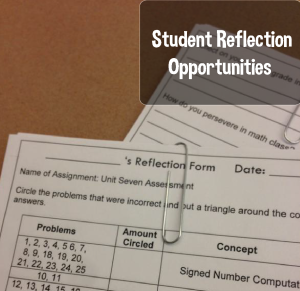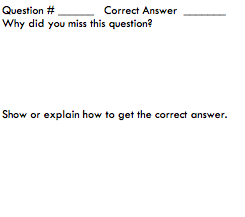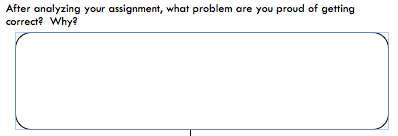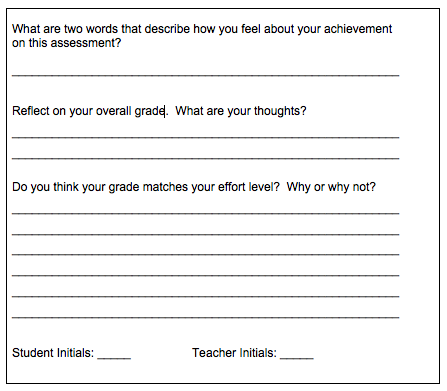
This year I’ve attempted to incorporate more student reflection opportunities in math classes. This reflection has taken on different forms. Reflecting on math practices is evident through classroom conversations and through student math journals I feel as though a heavy dose of student reflection can go a long way in having students build awareness of their strengths and areas that need bolstering. My focus this year has been geared towards students reflecting on their unit assessments. I want students to understand that reflecting on past performances and setting goals can help them improve going forward. I don’t believe all elementary students come to this conclusion all on their own.
At the beginning of the year I analyzed all the different methods to promote student reflection opportunities. The timing of student reflection matters. My classes generally have approximately 11 unit assessments throughout the year. Having formal reflection points after the assessments provide a number of checkpoints along the way. I decided to start by finding/creating student self-reflection templates.
My student reflection sheets have changed over time. The evolution of what was created can be found below.
1.)

At the beginning of the year students were asked to find problems that were incorrect and delve deeper into the reasoning. Students had to seek out why a problem was incorrect and explain how to find a correct solution. This offered little interaction between the student and teacher, although some students would come up to the teacher to get further clarification on specific concepts.
2.)

The above portion was added to the first and helped students focus on positive elements of their performance while still addressing areas of improvement.
3.)

One major area that I thought needed strengthening was in the perseverance department. The above section was added to help students find strategies that they could use when approaching a complex problem.
4.)

Around the third unit assessment I decided to merge a more standards-based grading approach. I had students identify which problems were associated with certain math strands. Students then analyzed those results to look at possibly setting a relative math goal.
5.)

By this time students were becoming more reflective learners. I liked what I was seeing and felt like students were benefiting from this reflection opportunity. I added more pieces that emphasized having a growth mindset – e.g. connecting to achievement. This was also the first time that I had students and teachers sign-off on the reflection. I was able to have short discussions with the students about their assessment.
6.)


Around the fifth unit assessment I added a goal setting part to the reflection sheets. I haven’t tweaked the reflection sheet much since then feel the results are positive. Students are not as infatuated with the letter grade, but more focused on specific concept areas of the test.
I’ve used this sheet for the last few unit assessments. It’s in a Word format so feel free to edit it and make it your own. There’ll never be a perfect student reflection sheet but this has worked well for my students. Moreover, students are able to look back through their math journals and see their own growth over time.
Last week I passed back a graded unit assessment back to a group of fourth grade students. Each student took a peek at their paper, looked over their problems and grabbed their math journals. Students found a comfy place in the room to reflect on their results and set goals for the next unit. After students finished the reflection they brought the sheet up to me to discuss the reflection and next steps. We both signed-off on the reflection and the students move on to another activity.
This process of math reflection seems to help my students. It does take up around 30-45 minutes or so, but I feel like it’s time well spent.
How do you use student reflection in the math classroom?
If you had it to do over again, (Wait! That’s called Fall, right? 🙂 would you start with this last reflection form, or do you think that students benefited from moving through the increasing levels of complexity in reflection? Thanks for this post.
LikeLike
The process of introducing a bit more each time seemed to work well. Although it wasn’t planned that way, the reflection sheets added a bit more student responsibility each time. It took a while to develop student trust through the reflection process and that might not have been possible if I went with the last sheet right away.
LikeLiked by 1 person
Thanks for sharing your thoughts and work. I appreciate your reflection.
LikeLiked by 1 person
I have just begun using student reflections by strand this semester. I currently teach a resource Alg II class. I began last semester with having students correct and do error assessments problem by problem. There wasn’t much chance, as you noticed, to interact, unless we were correcting as a class, much like your first section. This semester, I had them begin to analyse by strand – to see weaknesses AND strengths. I love your piece for goal setting, and feel that would be a good addition to my students’ current unit analysis for the upcoming week. It does take time to do this, but I think one of the best skills we can share is that of being a reflective learner. Our children need to learn the true value in testing: it is not the end of a unit, it is the beginning of our next step, showing us only where we are, not who we are. This reflection allows a resetting of our personal compasses; we move on from there. I like all of the steps you’ve incorporated. Thank you for sharing.
LikeLiked by 1 person
Thanks for dropping by and leaving a comment. I especially appreciate your comment relating to students being reflective learners. This is such an important piece and emphasizes the need for students/teachers to have a growth mindset and the perspective that learning is a journey.
LikeLiked by 1 person
Love that students immediately reach for their journal after taking an assessment! I want to work on a reflection process where student have the choice – journal, FlipGrid, draw – to explain where they are in the learning process, where they want to go, and the steps they need to take to get there!
LikeLiked by 1 person